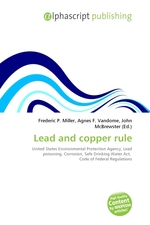Lead and copper rule
Frederic P. Miller, Agnes F. Vandome, John McBrewster
бумажная книга
High Quality Content by WIKIPEDIA articles! The "Lead and Copper Rule", or LCR, was published by the United States Environmental Protection Agency in 1991 to limit the concentration of lead and copper allowed in public drinking water at the consumer's tap, as well limiting the permissible amount of pipe corrosion occurring due to the water itself. EPA promulgated the regulations following studies that concluded that copper and lead have an adverse effect on individuals. The LCR sought to therefore limit the levels of these metals in water through improving water treatment centers, determining copper and lead levels for customers who use lead plumbing parts, and eliminating the water source as a source of lead and copper. If the lead and copper levels exceed the "action levels", water suppliers are required to educate their consumers on how to reduce exposure to lead. A 2004-2005 study of the LCR by the EPA noted that the system had been effective in 96% of systems serving at least 3,300 people.
Данное издание не является оригинальным. Книга печатается по технологии принт-он-деманд после получения заказа.


